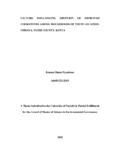Factors influencing adoption of improved cookstoves among households of Thuti Location, Othaya, Nyeri County, Kenya

View/
Date
2018Author
Nyankone, Benson O
Type
ThesisLanguage
enMetadata
Show full item recordAbstract
Majority of the rural households in developing nations use traditional cooking devices with high-energy inefficiency and biomass use. The result is a high pressure on forests that serve as sources of firewood. Improved cookstoves have been promoted as a potential solution to slowing the loss of biomass. The major aim of the study was based on the assessment of factors influencing adoption of improved cookstoves among households in Thuti location, Othaya. To achieve this, the study assessed the cooking devices and energy use among study households, determined factors associated with the adoption of improved cookstoves, and assessed the benefits of adopting and using improved cookstoves among households in Thuti location. A sum of 101 households were randomly selected from the 1006 households in Thuti village and questionnaires administered. More than half of the households (54%) reported using improved three stones as the cooking devices, and 23% used the traditional three stones method, while 24% used ceramic jiko, concrete insulated stove, multipurpose stove, jiko koa, LPG gas, biogas, pot jiko and scode firewood stoves. Forty- five percent of the household reported that they used the cooking devices because of their speed in cooking and being economical. More than two-third (68%) of the households were aware of the cookstoves. The main source of this information was neighbours, seminars and meetings. The cooking devices were priced between Kenya shillings 100 and 1000, with the cookstoves obtained from local Jua Kali contributing 43% of total cookstoves owned by households. Two-thirds of the study households indicated cost effectiveness and availability of fuels as the major factors influencing adoption and uses of the improved cookstoves, with majority of the respondents favouring them as economical
to use. In conclusion, initiatives aimed at adoption of improved cookstoves should up scaled by effective dissemination of information on the characteristics of cooking devices. To increase adoption of cookstoves, I recommend increased awareness of their benefits and affordable pricing of the devices and energy/fuels including options such as financing or subsidies by major stakeholders and the government.
